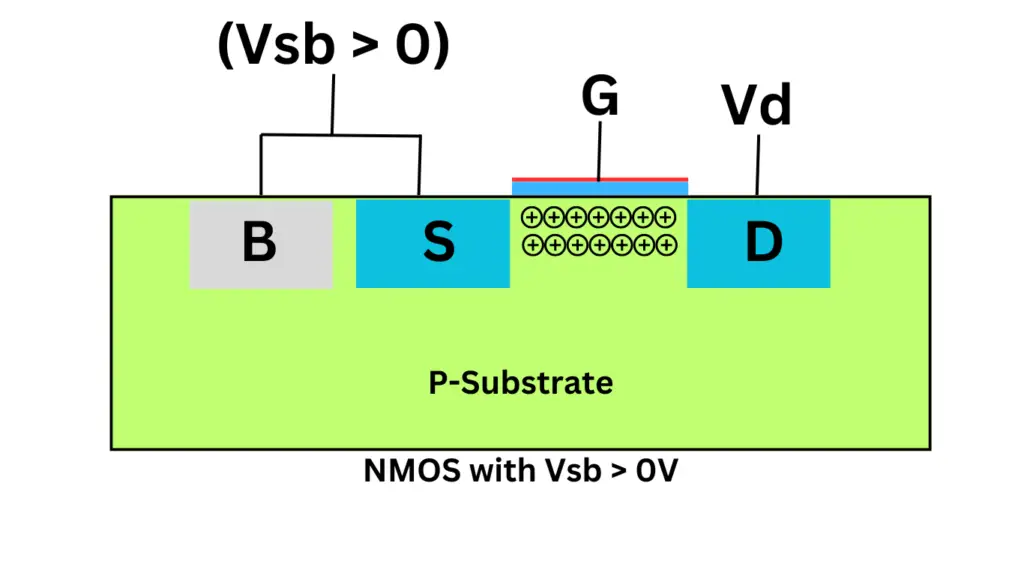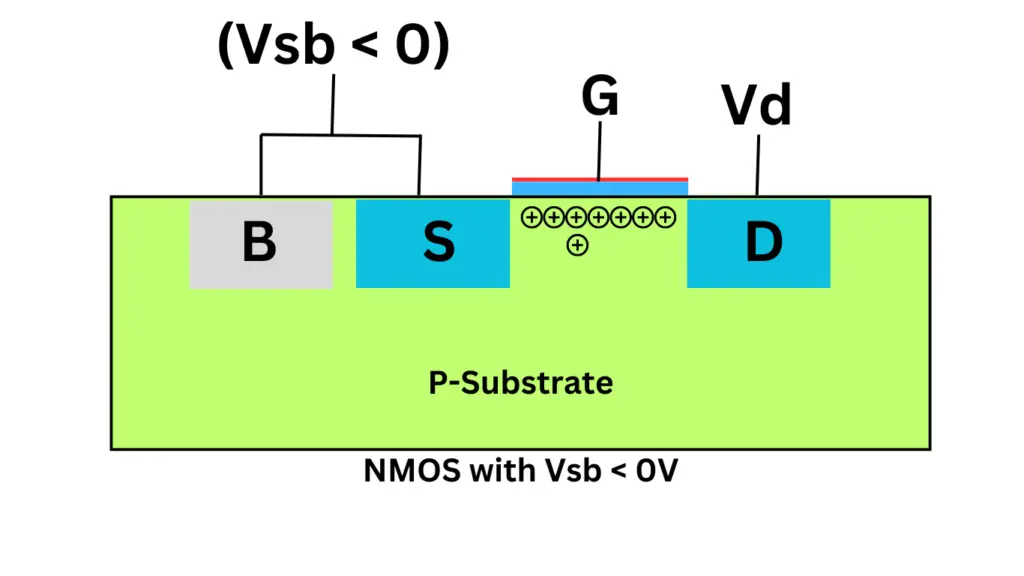The Body (Back Gate) Effect is a phenomenon in MOS transistors where the threshold voltage (VT) of the transistor changes due to a voltage applied to the transistor’s body (or bulk). Normally, the transistor is controlled by the gate voltage, but the body can also influence how the transistor behaves.
What is Depletion Layer?
When a transistor is operating, a layer under the gate called the depletion layer forms. This layer controls how much current can flow through the transistor. Now, if you apply a voltage between the body (or bulk) and the source of the transistor, this changes the thickness of that depletion layer. As a result, the transistor will need more voltage on the gate to turn on properly. This means that the threshold voltage increases when you apply a back-bias (body) voltage.
nMOS Transistor (Negative gate voltage to body)
Positive Body Voltage (Vsb > 0): When you apply a positive voltage between the source and body, it increases the threshold voltage (VT). This happens because the positive body voltage widens the depletion region in the p-type body under the nMOS channel. As a result, the transistor requires a higher gate voltage (Vgs) to turn on, making it harder for the channel to conduct. This leads to a reduction in the drain current (Id) for a given gate voltage.

Negative Body Voltage (Vsb < 0): If you apply a negative voltage between the source and body, the opposite happens. The depletion region becomes thinner, lowering the threshold voltage (VT). This makes it easier for the transistor to turn on, so the current increases for the same gate voltage.

pMOS Transistor (Positive gate voltage to body)
In a pMOS transistor, the behavior is similar but reversed due to the opposite doping type (p-type channel and n-type body):
Negative Body Voltage (Vsb < 0): For pMOS transistors, a negative body voltage decreases the threshold voltage (VT). This makes it easier for the pMOS to conduct at lower gate-source voltages, resulting in an increase in current flow. Essentially, the transistor becomes more sensitive to the gate voltage.
Positive Body Voltage (Vsb > 0): If you apply a positive voltage between the source and body, the depletion region thickens, increasing the threshold voltage (VT). This makes it harder for the pMOS to turn on, reducing the current flow through the transistor.
Use of Body Effect in CMOS?
Control Over Threshold Voltage: By applying a back-bias voltage, we can raise the threshold voltage, giving more control over the transistor’s operation.
Lower Power Leakage: Increasing the threshold voltage helps reduce unwanted current (leakage) when the transistor is off, which is useful for designing low-power devices
Improved Performance: The back-bias effect can reduce some unwanted capacitance in the transistor, which may help with performance.
Overall, the Body (Back Gate) Effect gives you an extra tool to control how a MOS transistor works, making it an important factor to consider when designing circuits.
Conclusion
- In nMOS, a positive body voltage increases VT (harder to turn on), while a negative body voltage lowers VT (easier to turn on).
- In pMOS, a positive body voltage increases VT (harder to turn on), while a negative body voltage lowers VT (easier to turn on).
In both cases, the back gate (or body) voltage provides a secondary way to control the transistor, which is why it’s sometimes used to fine-tune the performance of circuits, such as reducing leakage in low-power designs or compensating for variations in threshold voltage.